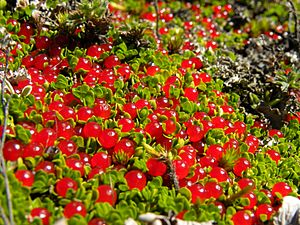Coral bead plant facts for kids
Quick facts for kids Coral bead plant |
|
|---|---|
 |
|
| Scientific classification | |
| Kingdom: | |
| (unranked): | |
| (unranked): | |
| (unranked): | |
| Order: | |
| Family: | |
| Subfamily: |
Rubioideae
|
| Tribe: |
Anthospermeae
|
| Genus: |
Nertera
|
| Species: |
N. granadensis
|
| Binomial name | |
| Nertera granadensis |
|
| Synonyms | |
|
List
|
|
Nertera granadensis, also known as the coral bead plant, pin-cushion plant, coral moss, or English baby tears, is a small plant that grows close to the ground. It's famous for its bright orange berries! This plant belongs to the Nertera group.
It grows in many places around the Pacific Ocean. You can find it from southern Chile all the way north to Guatemala. It also grows in places like Hawaii, New Zealand, Australia, and parts of Asia like Indonesia and the Philippines. In hot, tropical areas, it usually grows high up in the mountains where it's cooler. People sometimes grow it in their gardens because it looks pretty. In some places, like Chile, it's called rucachucao. The name granadensis comes from "New Granada," which was an old name for Colombia.
Contents
How to Care for Coral Bead Plants
This plant can be a bit tricky to look after, especially if you're new to gardening.
Planting and Location Tips
The soil for your coral bead plant should be porous. This means it should drain water easily. It's best to keep the plant in a bright spot, but not in direct sunlight. A window that faces the tropics (like a south-facing window in the Northern Hemisphere) is often perfect.
Temperature and Outdoor Care
During the summer, you can move your Nertera granadensis outdoors. Just make sure it's still protected from strong direct sunlight. The temperature shouldn't be too hot. In winter, the temperature should not drop below 8 degrees Celsius (about 45 degrees Fahrenheit).
Watering Your Plant
In winter and autumn, let the soil dry out a bit between waterings. When spring arrives and the flowers and berries start to grow, you should water more often. During spring and summer, keep the soil moist all the time. You can also lightly spray the leaves and berries with water sometimes, but not too often, or they might rot.
Feeding Your Plant
From spring to summer, until the plant starts to flower, feed it once a month. Use a weak liquid fertilizer, diluted to half the strength recommended on the package. When the berries start to turn black, it means they are dying. Carefully remove them from the plant.
Is the Coral Bead Plant Safe?
The coral bead plant has bright, colorful berries. These might look appealing to young children or pets. Luckily, the plant is not very poisonous. There are no known harmful substances in its parts.
One study looked at 21 children who had eaten parts of the plant. Only five of them showed mild signs of being unwell, like feeling tired, having stomach pains, or throwing up. Also, a two-and-a-half-year-old child ate 20 of the berries and didn't show any bad effects at all. So, while it's always best not to eat unknown plants, the coral bead plant is considered quite safe.


